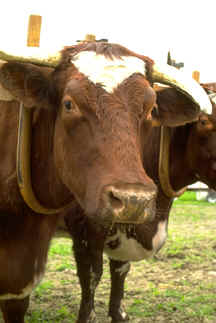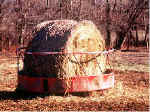

To send a message to an author, click on the author's name at the end of the article.
This Month in Ag Connection | Ag Connection - Other Issues Online
Families using portable kerosene heaters to offset rising home heating bills should be aware of safety hazards particular to those heating systems. "The new generation of kerosene heaters is equipped with many safety features, but they are not hazard-free," said Karen Funkenbusch, University of Missouri safety specialist.

Careless refueling, using gasoline instead of kerosene, and improperly storing flammable liquids can cause house fires and other serious problems. There are also health hazards from pollutants that an unvented kerosene heater puts into a building.
Funkenbusch offers the following tips for safe use of these heaters:
Provide adequate ventilation according to the manufacturer's instructions. If no specifications are listed, a good rule of thumb is one square inch of window opening for each 1,000 BTUs of heater rating.
"Use kerosene heaters only as a supplemental heat source except in emergency situations," Funkenbusch said. "Do not operate a heater while you are asleep and never leave a heater unattended."
For more information, see UMC Guide: 1991, Unvented Portable Kerosene Heaters - Safety Considerations: http://extension.missouri.edu/publications/DisplayPub.aspx?P=G1999
(Source: Karen Funkenbusch, funkenbuschk@missouri.edu)
This Month in Ag Connection Ag Connection - Other Issues Online
Temple Grandin, an internationally recognized animal behavior expert and associate professor of animal science at Colorado State University, recently spent a day at the University of Missouri, sharing her experiences with students, faculty, staff and the community. Growing up as an autistic child, Temple Grandin saw the world from a different point of view, where her thoughts took the form of pictures, and where she noticed little details that no one else did. She saw the world as animals do.
"The same things that scare autistic kids scare animals," she told a standing-room-only crowd during a public presentation on November 12, 2003 at the MU campus. "You have to take the animal's place and see how an animal looks at things."
Grandin is known for her work on design of livestock handling facilities and study of animal behavior. She has developed critical control points in the raising, handling and slaughter of livestock. She has consulted with restaurants that want to purchase meat from slaughter plants that employ humane methods of handling livestock during slaughter, as well as purchase from farms that employ humane methods.
The following is an example of the critical points you would use to evaluate a beef operation:
Beef Ranch (Cow Calf and Stocker Pasture Operations)
The following web site gives the critical control points that have been developed for feedlot and stocker operations: http://www.grandin.com/cattle.welfare.ccp.html
The critical control points for dairies is at the following web site: http://www.grandin.com/cow.welfare.ccp.html
Other information on slaughter and handling are given at this site: http://www.grandin.com/meat.institute.menu.html
The National Pork Board has developed the Swine Welfare Assurance Program (SWAP) to assist hog producers to evaluate their operations. More information on this program can be obtained at: http://www.pork.org/Home.aspx
Dr. Grandin's web site is full of information on livestock handling. If you haven't visited it, take a look. You will likely find something useful for your farm: http://www.grandin.com/
Most farmers do use humane methods of raising their livestock. Farmers should all take a close look at the practices on their farms. This can become a strong marketing tool. Many consumers want to know the products they purchase in the store are raised in a humane, safe and sanitary way.
(Author: Don Day, Natural Resource Engineer/Information Technology Specialist)
This Month in Ag Connection | Ag Connection - Other Issues Online

The Show-Me-Select (SMS) Heifer Development Program began in 1997 as a grant funded pilot designed to help Missouri beef producer improve their heifer development programs through the use of a Total Quality Management approach. Beginning January 1, 2004 the SMS program will privatize and incorporate and become a not for profit corporation whose official name is "Show-Me-Select Replacement Heifers, Inc." Producers who have participated in the program previously, should have received an invitation to the first annual meeting scheduled January 6, 2004.
There were seven SMS sales this fall around the state. At the sales, 1728 heifers sold for an average of $1122 per head. The sale averages ranged from $1073 to $1155 with the Central Missouri Region sale at Sedalia averaging $1078 per head.
Producers interested in participating in the SMS program in 2004/2005 will need to have their heifer enrollments and membership dues to their local livestock specialist by February 1, 2004 for sales in the fall of 2004 and by September 1, 2004 for sales in the spring of 2005. Enrollment deadlines for the sales are firm!
(Author: Mark Stewart, Livestock Specialist)
This Month in Ag Connection | Ag Connection - Other Issues Online

The weather pattern last spring was a cool wet one, which probably cut down on the quality of hay for some producers. For example, did you know that a 2-inch rain on curing alfalfa causes a 16.4% leaf loss (verses 8.8% with no rain) and a reduction of 27.7% of its nutrients? The same rain on red clover causes a 16.8% leaf loss (verses 10.5% with no rain) and a nutrient reduction of 32.5% due to leaching and respiration. Some producers might have waited to cut their hay so they would not be cutting during the midst of the monsoon season. Since the rain didn't stop until June, some might have had to wait to cut their forage when it was more mature. You have heard it before - more mature grass tends to be lower quality, lower quality hay has less available nutrients for your livestock and feeding low quality hay could turn into having to buy expensive supplements, etc.

The best way to measure hay quality is to evaluate it by making a small investment to get the hay sample analyzed. Many Extension offices have a hay probe that can be used to obtain core samples from a couple of representative bales of hay. The samples can be sent to a laboratory for analysis. A producer or hay grower can get a test for moisture, crude protein, calcium, phosphorus, and magnesium for less than $20.00, but the information could save money in the long run. For more information please call your local Extension Specialist.
(Author: Wendy Flatt, Livestock Specialist)
This Month in Ag Connection | Ag Connection - Other Issues Online
Most of the recent changes in the federal income tax code have been quite friendly for small business owners. The increase of the maximum Section 179 deduction up to $100,000 and the increase of the first-year bonus depreciation from 30% to 50% enable most small businesses, with capital acquisitions, the ability to easily manage their taxable income for 2003. For example, if a farmer purchased a new piece of 7-year life farm equipment for $150,000 after May 5, the total write-off for 2003 could vary (at the farmer's discretion) from $7,500 to $128,572. The following table presents the range of write-off alternatives for this asset.
| ADS (SL) - 10 years, no Section 179, no bonus depreciation | $7,500 |
| MACRS (150%) -7 years, no Section 179, no bonus depreciation | 21,435 |
| MACRS (150%) - 7 years, no Section 179, 30% bonus depreciation | 60,004 |
| MACRS (150%) - 7 years, no Section 179, 50% bonus depreciation | 85,718 |
| MACRS (150%) - 7 years, max. Section 179, no bonus depreciation | 107,145 |
| MACRS (150%) - 7 years, max. Section 179, 30% bonus depreciation | 120,002 |
| MACRS (150%) - 7 years, max. Section 179, 50% bonus depreciation | 128,572 |
| ADS - Alternative Depreciation System | |
| SL - Straight-line Depreciation Method | |
| MACRS - Modified Accelerated Cost Recovery System | |
| 150% - 150% - Declining-Balance Depreciation Method | |
(Author: Parman R. Green, Ag Business Mgmt. Specialist)
This Month in Ag Connection | Ag Connection - Other Issues Online
Publishing Information
Ag Connection is published monthly for Northeast and Central areas of Missouri producers and is supported by the University of Missouri Extension, the Missouri Agricultural Experiment Station, and the MU College of Agriculture, Food and Natural Resources. Managing Editor: Mary Sobba.